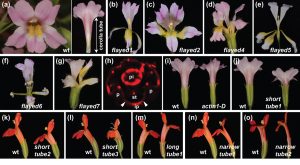About one-third of the ~275,000 angiosperm species (i.e., the Asteridae clade) produce flowers with fused petals forming a corolla tube. The various elaboration of the corolla tube (e.g., making it longer, wider, twisted) has enabled Asteridae plants to exploit many specialized pollinator groups (e.g., hawkmoths, hummingbirds, beeflies), which in turn drives the rapid diversification of floral forms. However, the developmental genetics of corolla tube formation and elaboration is little known, largely because the conventional plant genetic model system, Arabidopsis, does not have fused petals.
In this project we use chemically induced mutants of M. lewisii and M. verbenaceus (Figure 1) to elucidate the genetic network that regulates corolla tube formation and elaboration. Our analysis of the flayed1 and flayed2 mutants (Ding et al., 2020) suggested that the tasiRNA-ARF pathway is required for corolla tube formation and led to the formulation of a new conceptual model highlighting the central role of auxin-directed synchronized growth of the petal primordium base and the interprimordial region in corolla tube formation.
